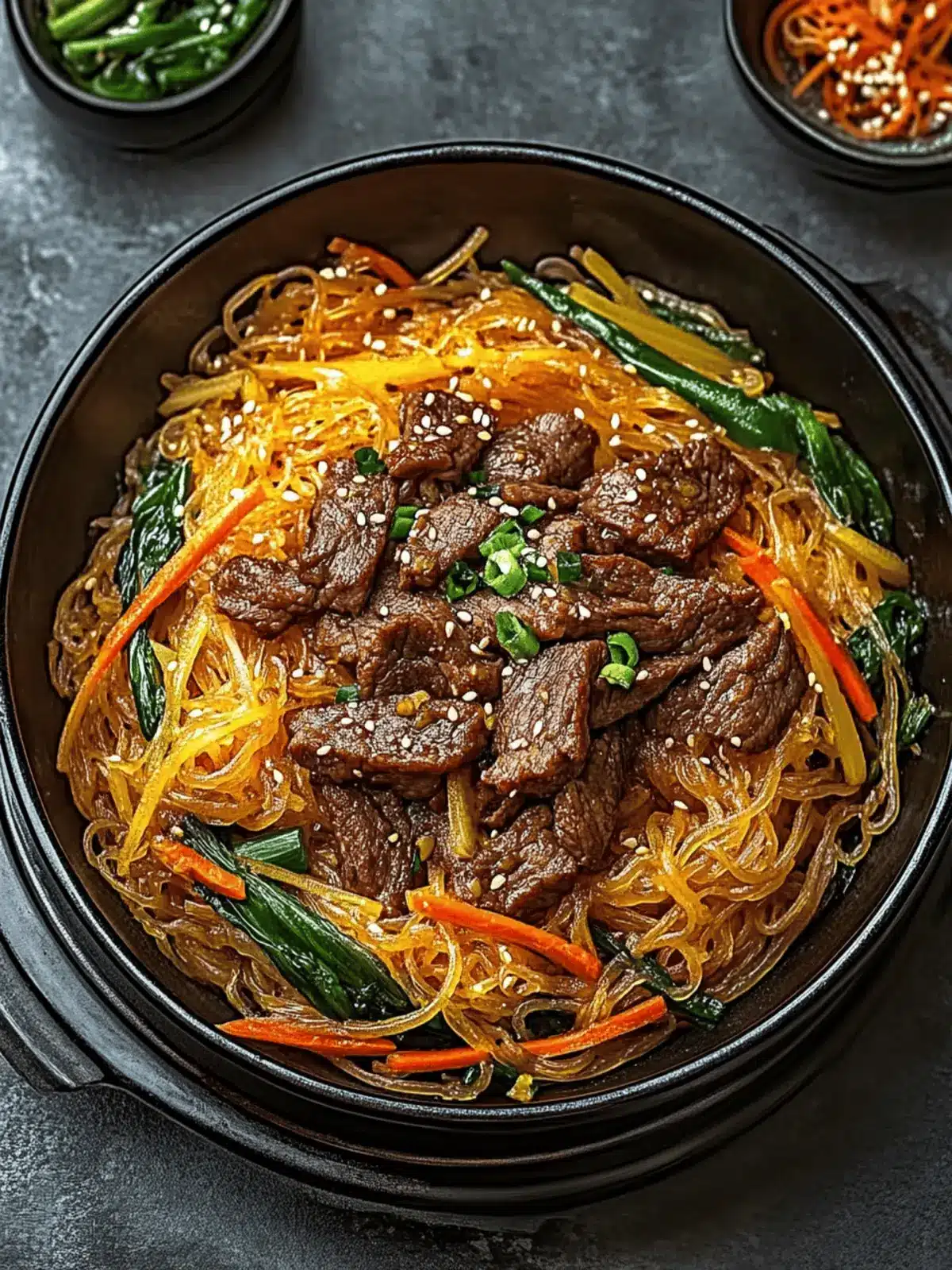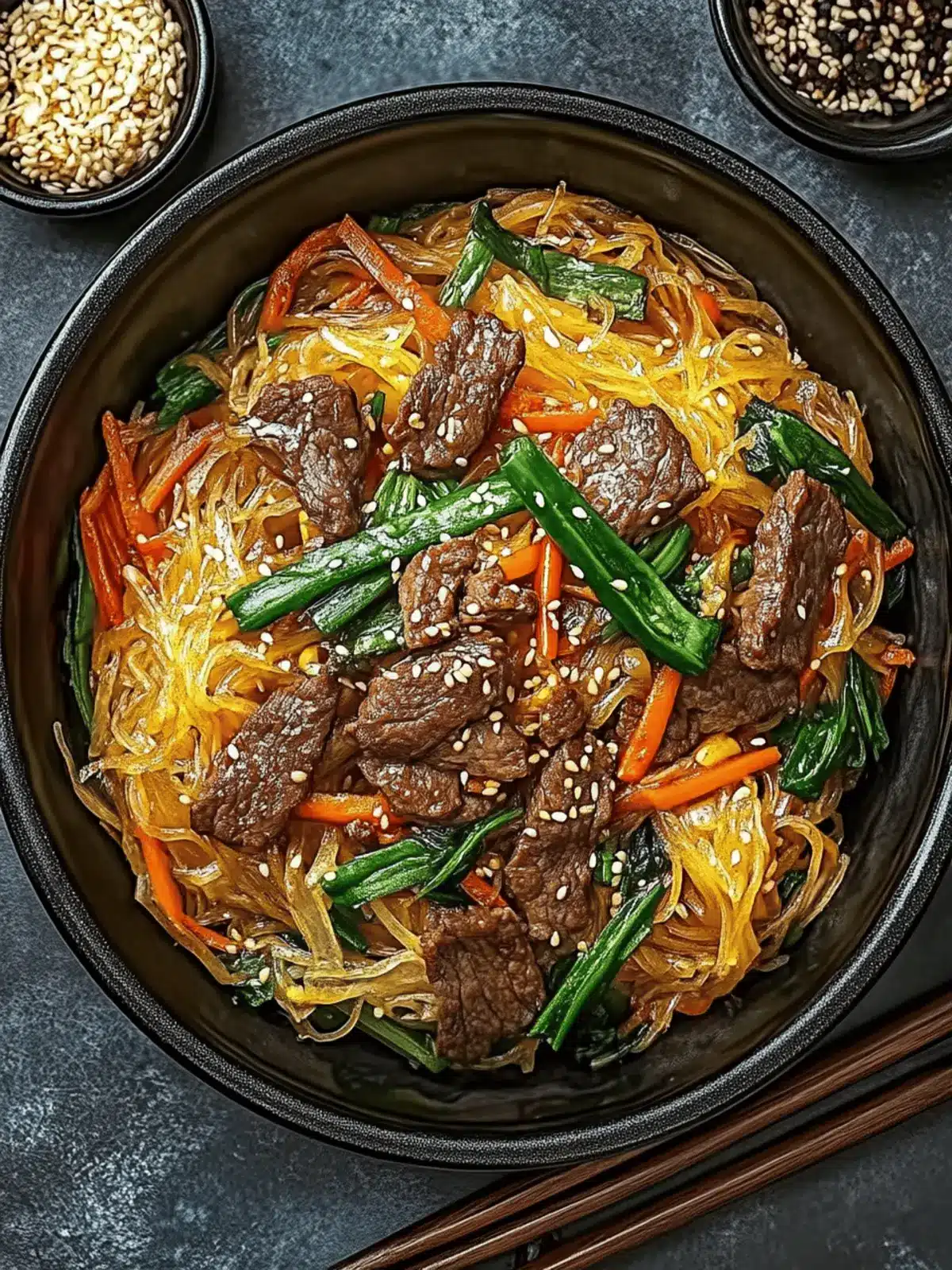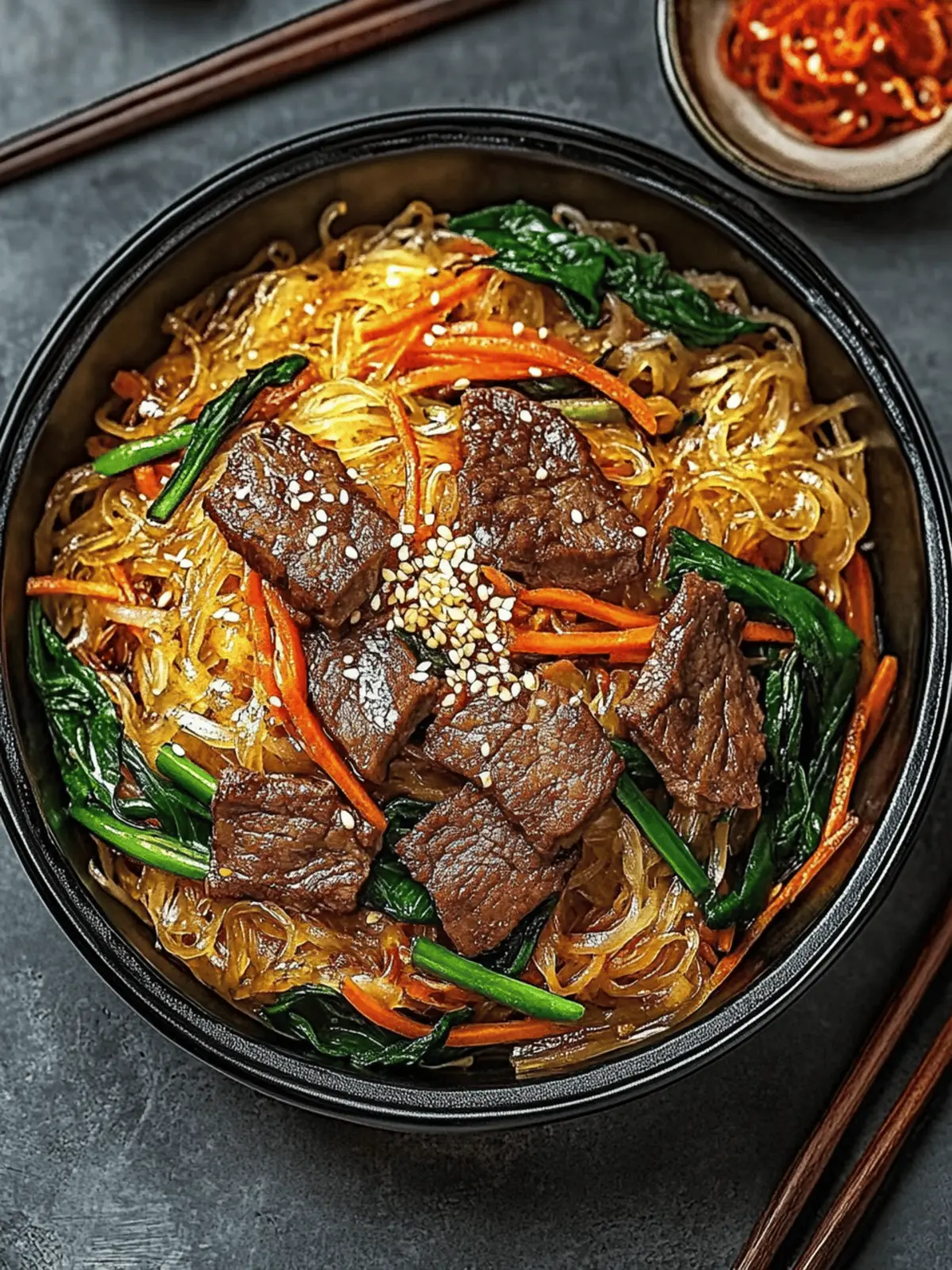As the vibrant colors of fall begin to paint the landscape outside my window, I find myself craving the warmth of homemade dishes that embrace the spirit of comfort and celebration. That’s when I turn to Japchae, a traditional Korean favorite that beautifully marries sweet potato glass noodles with a medley of colorful vegetables and tender protein. The first time I twirled those velvety noodles around my fork, I was enchanted by their chewy texture and the sweet, savory layers of flavor created by soy sauce and sesame oil.
What I love most about Japchae is its versatility—whether you prefer the hearty richness of beef, the delicate crunch of tofu, or a spicy kick with gochujang, this dish easily caters to all palates. Perfect for cozy weeknight dinners or festive gatherings, Japchae is not only a feast for the senses but also a wholesome dish that brings people together. So, let’s dive into this delightful recipe that is bound to become a staple in your cooking repertoire!
Why is Japchae a must-try dish?
Versatile Customization: Japchae allows you to tailor each serving to your liking—choose beef, chicken, or tofu as your protein.
Colorful Veggies: Incorporate fresh vegetables like bell peppers and spinach for a vibrant look and nutritious boost.
Easy Cooking: With minimal prep and quick stir-frying, creating Japchae is a breeze for both seasoned chefs and kitchen novices.
Savory-Sweet Harmony: The balance of flavors from the soy sauce and sesame oil makes every bite memorable.
Ideal for Celebrations: Traditionally made for special occasions, Japchae brings a festive touch to any meal, making it great for gatherings or cozy nights in!
Japchae Ingredients
• Dive into this delicious dish!
For the Noodles
- Sweet Potato Glass Noodles – Essential for authentic Japchae; these provide that wonderfully chewy texture you won’t want to miss.
For the Protein
- Beef (sliced thinly) – Adds rich flavor and heartiness; feel free to swap it for chicken or tofu to suit your taste!
For the Sauce
- Soy Sauce – Key for that umami punch; low-sodium soy sauce can make it healthier.
- Sesame Oil – Adds a delightful nuttiness; avocado oil is a great lighter substitute.
For the Vegetables
- Carrots – Bring a natural sweetness and color; use julienned for even cooking.
- Spinach – Packed with nutrients and a splash of green; fresh is best!
- Bell Peppers – Choose any color for a vibrant dish; they add crunch and flavor.
For Garnishing
- Green Onions – For a fresh finish; chop finely to sprinkle over just before serving.
For Extra Spice (optional)
- Gochujang – Korean chili paste that adds heat; adjust based on your spice preference for a punchy finish!
How to Make Japchae
-
Soak Noodles: Begin by soaking the sweet potato glass noodles in warm water for about 30 minutes. You’ll want them to soften and become pliable for the stir-fry.
-
Drain and Prep: Once the noodles are soft, drain them and set them aside. This step is crucial to ensure they’re ready for stir-frying without being overly soggy.
-
Stir-Fry Beef: In a hot skillet, add a splash of oil and stir-fry the thinly sliced beef until it’s browned and cooked through, roughly 3-5 minutes. Remove it and set it aside.
-
Cook Vegetables: In the same skillet, add a bit more oil if needed, then stir-fry your colorful veggies (carrots, bell peppers, and spinach) for 3-4 minutes until they’re tender but still crisp.
-
Combine Everything: Return the beef to the skillet and add the softened noodles, soy sauce, and sesame oil. Toss everything together, ensuring the noodles are well-coated and warmed through, about 2-3 minutes.
-
Finish and Serve: Stir in the chopped green onions and, if using, add some gochujang for a spicy kick. Mix well and serve hot, making sure to enjoy the beautiful flavors you’ve created!
Optional: Top with sesame seeds for an extra crunchy finish.
Exact quantities are listed in the recipe card below.
Make Ahead Options
These Japchae noodles are absolutely perfect for meal prep enthusiasts! You can prepare the sweet potato glass noodles and chop your vegetables up to 24 hours in advance. Store the noodles in a sealed container with a little water to prevent drying out, while the vegetables can be kept in a damp paper towel to maintain freshness. When you’re ready to serve, simply stir-fry your beef or protein of choice, toss in the prepped veggies and noodles, and add your soy sauce and sesame oil. This way, you’ll have dinner on the table in no time, with all the delicious flavors intact!
What to Serve with Japchae?
When you’re ready to elevate your Japchae experience, consider these delightful pairings that not only complement the dish but also enhance your meal.
-
Korean Rice: Serve alongside fluffy white rice for a satisfying balance, soaking up the delicious flavors of the soy sauce and sesame oil.
-
Kimchi: The tangy and spicy notes of kimchi add a delightful contrast to the sweet and savory flavors of Japchae. It’s a must-have for any Korean meal!
-
Pickled Vegetables: These crunchy bites bring brightness and acidity to the table, perfectly cutting through the richness of the noodles.
-
Korean Fried Chicken: Crispy and flavorful, it pairs wonderfully with the tender noodles and adds a fun, festive touch for gatherings.
-
Miso Soup: Light and comforting, miso soup offers a warming contrast that complements the chewy texture of the glass noodles beautifully.
-
Sesame Spinach Salad: The fresh, nutty flavors of this simple salad will enhance the freshness of the vegetables in your Japchae while adding a crisp texture.
-
Green Tea: A gentle cup of green tea cleanses the palate, harmonizing with the umami notes of the dish while offering a calming element.
-
Mango Sorbet: For a refreshing dessert, a scoop of mango sorbet adds a bright sweetness that rounds off the meal perfectly after the savory Japchae.
Each of these pairings creates an inviting and memorable dining experience, ensuring your Japchae is the highlight of your meal.
Japchae Variations & Substitutions
Feel free to explore exciting twists and substitutions to make this dish your own!
-
Protein Swap: Replace beef with chicken or tofu for a different protein source that’s equally delicious.
-
Veggie Boost: Add mushrooms or snap peas for extra nutrition and crunch that enhances the overall dish.
-
Sauce It Up: Try tamari instead of soy sauce for a gluten-free option, keeping all the delightful flavors intact.
-
Spicy Kick: Increase gochujang for more heat, or toss in some fresh chili peppers for a fiery taste experience.
-
Nutty Flavor: Opt for roasted sesame seeds instead of sesame oil to add a crunchy texture and a nutty note.
-
Fresh Herbs: Mix in fresh herbs like cilantro or basil for a refreshing twist that elevates the flavor profile.
-
Zucchini Noodles: Use spiralized zucchini noodles as a lighter alternative to sweet potato noodles for a lower-carb version.
-
Sweet Touch: Add a drizzle of honey or maple syrup for a touch of sweetness that complements the savory elements beautifully.
Expert Tips for Japchae
-
Soak Carefully: Don’t over-soak the sweet potato noodles; 30 minutes is perfect for achieving that delightful chewiness in your Japchae.
-
High Heat Cooking: Use high heat while stir-frying to sear your beef and veggies quickly. This will lock in flavors and maintain a nice texture without overcooking.
-
Prep Ahead: Chop vegetables in advance and have all ingredients ready before you start cooking. This allows for a seamless stir-frying experience and prevents any burnt bits.
-
Customize Wisely: If you’re adding gochujang or other spices, start with a small amount. You can always add more if you prefer more heat in your Japchae!
-
Storage Tips: Leftover Japchae stores well in an airtight container but can soften. To revive it, just reheat briefly in a skillet to maintain texture.
How to Store and Freeze Japchae
Fridge: Leftovers can be kept in an airtight container in the refrigerator for up to 3 days. This will help retain flavor and freshness.
Freezer: For longer storage, freeze cooked Japchae in a sealed container or freezer bag for up to 2 months. Divide into portions for easy use later.
Reheating: To reheat, warm on the stove over medium heat for a few minutes, adding a splash of water or soy sauce to restore moisture and texture. Always check before serving to ensure the flavor is still delightful!
Room Temperature: Avoid leaving Japchae out at room temperature for more than 2 hours to ensure food safety and quality.
Japchae Recipe FAQs
What’s the best way to select sweet potato glass noodles?
When choosing sweet potato glass noodles for Japchae, look for packages labeled “sweet potato starch” or “glass noodles.” The noodles should be semi-transparent and not have dark spots or a dusty coating. If you can’t find these specific noodles, rice noodles are a great alternative, though the texture will differ slightly.
How should I store leftover Japchae?
Leftover Japchae can be stored in an airtight container in the refrigerator for up to 3 days. To keep it fresh, let it cool to room temperature first before sealing. It’s best enjoyed warmed up, so give it a quick sauté to bring back that flavor and texture before serving!
Advertisement
Can I freeze Japchae, and how?
Absolutely! To freeze Japchae, cool the cooked dish completely and then portion it into freezer-safe containers or bags, leaving some room for expansion. It can be frozen for up to 2 months. When ready to enjoy, thaw overnight in the refrigerator before reheating it on the stovetop with a splash of water or soy sauce to revive some moisture.
What if my noodles turn out mushy?
If you find your sweet potato glass noodles are mushy, it may be because they were over-soaked. To prevent this, soak them in warm water for about 30 minutes—just enough to soften but not too much to lose their chewy texture. If they do become mushy, try adding them to your stir-fry earlier to allow them to regain some texture while cooking with other ingredients.
Is Japchae suitable for people with dietary restrictions?
Yes, Japchae is quite customizable! For vegetarians, simply omit the beef and use tofu or increase the vegetable quantities. If you have issues with gluten, replace soy sauce with a gluten-free option. Always check specific ingredients like gochujang if you or your guests have allergies, as it can sometimes contain gluten or wheat products.
Can my pets eat Japchae?
While some ingredients in Japchae, like vegetables, might be safe for dogs or cats in small quantities, it’s best to avoid letting them eat it. Soy sauce, for instance, can be too salty for pets. If you want to share a treat with them, stick to plain, cooked vegetables without any seasoning!

Delicious Japchae: Customize Your Korean Noodles Today!
Ingredients
Equipment
Method
- Soak Noodles: Begin by soaking the sweet potato glass noodles in warm water for about 30 minutes.
- Drain and Prep: Once the noodles are soft, drain them and set them aside.
- Stir-Fry Beef: In a hot skillet, add a splash of oil and stir-fry the thinly sliced beef until browned, about 3-5 minutes. Remove and set aside.
- Cook Vegetables: In the same skillet, add more oil if needed, then stir-fry carrots, bell peppers, and spinach for 3-4 minutes until tender but crisp.
- Combine Everything: Return the beef to the skillet, add noodles, soy sauce, and sesame oil. Toss everything together for 2-3 minutes.
- Finish and Serve: Stir in chopped green onions and add gochujang if using. Serve hot.








